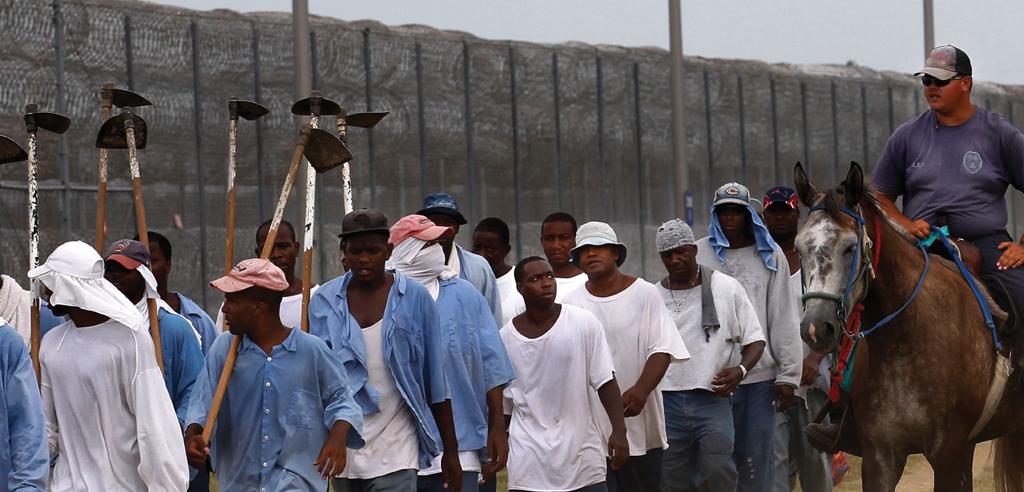The 13th Amendment seemingly abolished slavery on December 18th, 1865, but modern-day slavery is still alive through incarcerated people and the criminal justice system. If one is convicted of a crime, the 13th amendment is exempt, so slavery and involuntary servitude are permitted. The government and economy have reaped benefits from prisoners performing labor, thus creating the prison-industrial-complex, which is built on a relationship between prisons and the industry. Calvin Johnson, who served for seventeen years on the Orleans Parish Criminal District Court bench, explained to me how this industry is created in local Louisiana through sheriffs having local governments build jails, despite not needing these jails.

Prisoners at Angola state penitentiary
These local governments can house these state inmates, and the state will pay the local jailer to house these inmates — allowing this prison industrial complex to exist. When asked why we refer to this prison labor as “modern slavery,” Johnson explained how many people are locked up for small offenses and ultimately hired out for labor and to make money, which is modern slavery. There aren’t rehabilitation efforts made. If you look at other countries such as Denmark, Norway, or Sweden, you see a much different system. In Denmark, the majority of inmates serve their sentences in open prisons. This further allows incarcerated people to continue their studies and have part-time jobs outside prison walls.
Anne Marie Heckscher, the area manager of Denmark’s prison and probation service, tells how roughly 60% of inmates are placed in these open prisons, and most prisoners in closed facilities will ultimately finish their sentences in open prisons. She states in a Vice article how she would define open prisons as a prison without a fence. She highlights how prisoners are paid for the work they do or the education they receive. They are paid the equivalent of the minimum unemployment benefits allowed to Danish citizens (Unemployment benefits) as of 2022, which is DKK 19.351 per month (equivalent to 2,646 United states dollars).
Calvin Johnson highlighted the labor that inmates at Angola prison do, such as working in fields picking cotton and corn (many on the same fields enslaved people worked 200 years prior). Prisoners get paid $0.04 to $1.00 per hour. Regular (non-industry) work assignments are paid up to $.20/hour (https://www.legis.la.gov/legis/law.aspx?d=79438). Johnson also detailed how inmates not only perform industry jobs, but twenty to twenty-five inmates also work inside the capitol on three different crews. These crews are one for the senate, house, and governor’s office suite. In addition, another fifteen to eighteen offenders tend to the landscaping outside. About sixteen inmates work in the governor’s mansion.
When asked how Mr. Johnson thought incarcerated people should be allocated to spend their time, he said he thought that it would make sense for us to do things proactively with them to make them better. There are educational programs as well as job training programs in jail within these state institutions, such as Angola. However, he explains, once they are released from jail, they’re still labeled felons. Louisiana has three hundred eighty-nine restrictions on employment for felons, while the national average is one hundred twenty-three. (https://jobgap2013.files.wordpress.com/2016/02/ajs_job_after_jail_report_final_pdf.pdf)
Every state limits people with felony convictions. These bans include obtaining specific business licenses and occupations such as police officers, security guards, secondary school teachers, veterinarians, and pharmacists. The healthcare field, which includes many high-paying jobs, has the most restrictions, rounding out at 58 restrictions. In addition to these restrictions, formerly incarcerated people are restricted from government assistance programs, such as government housing and food stamps. These restrictions make it nearly impossible for people to make a better life for themselves following being released from prison.
Johnson explained and reiterated that if the goal of the prison system were rehabilitation, then Louisiana wouldn’t be the world’s prison capital. He experienced these injustices firsthand in 1963 during the civil rights demonstrations. He depicted the violence he experienced, such as teargas. When he was sixteen, he attended peaceful demonstrations with other black teenagers to integrate his high school in Iberville Parish. He ultimately was convicted of inciting a riot, despite a mob of white men attacking the teens. He explained that even today, almost fifty-nine years ago, he can think about teargas and not only remember it but smell it.
Governor John Bel Edwards formally apologized to Johnson for being wrongfully convicted and prosecuted. Johnson says how this apology not only applied to his situation but to those who also experienced these same injustices in Louisiana in that fashion. He tells how he was overwhelmed when he received the apology and never expected it to happen. He says that despite so much changing since 1963, we are going backward in this country.
This piece is part of the “Punishment and Redemption” series. The class and writing workshops that produce the content for this series is taught by Professor Betsy Weiss at Tulane University.
 NOLAbeings
Multimedia artist Claire Bangser created NOLAbeings as a portrait-based story project that marries...
NOLAbeings
Multimedia artist Claire Bangser created NOLAbeings as a portrait-based story project that marries...
 Data corner: Adobe Suite (create a PDF, social media graphic, presentation, edit a photo and video
Data corner is where you go to work with analytics and top tech skills. It takes on everything from PERL and SQL to Canva and Sprout Social.
Data corner: Adobe Suite (create a PDF, social media graphic, presentation, edit a photo and video
Data corner is where you go to work with analytics and top tech skills. It takes on everything from PERL and SQL to Canva and Sprout Social.
